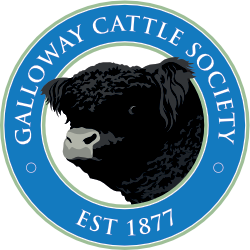The Galloway cattle breed is one of the oldest native breeds in the world. Thought to have originated in Kirkcudbrightshire and Wigtownshire, there are references to the black polled Scottish native cattle of the area recorded as far back as the sixteenth century. The Galloway breed today remains predominantly black in colour, although dun and red colours also fall within the Society’s remit.
The Galloway is considered a natural capital asset of south west Scotland, ideally co-adapted to the landscape, climate and environment, and consequently requiring minimal intervention and minimal inputs to thrive. The breed is notable for its unique double-layered coat which makes Galloways particularly hardy, and encourages good intramuscular fat marbling in the resulting beef.
The Galloway Cattle Society of UK and Ireland was formed in 1877 and registered as a charity in 1944. The Society is based in Castle Douglas, within the Galloway and Southern Ayrshire Biosphere; the UNESCO organisation which shares its name with the originating place of the breed.
In the 1950s and 60s the breed enjoyed success as the beef market demanded low input (feed) cattle that produced high quality meat.
The intensification and standardisation required by the market more recently - with the rise of retail multiples - saw continental breeds that finished faster favoured. This, combined with the devastating loss of many Galloway herds during the 2001 foot and mouth disease outbreak, led to the long-term decline of the breed, which resulted in registered stocking levels of the breed falling to such an extent that by 2016 the Galloway breed was named on DEFRA’s ‘at risk’ register.
The Galloway Cattle Society began a programme of member consultations and market development in 2016 which has reversed that trend. This has resulted in Galloway Beef being showcased in major retailers including Aldi Scotland and Farmison and in 2023 the Galloway was removed from the breed at risk register.
The south of Scotland remains the main stronghold of the Galloway breed, but demand has been growing in the north of England, Ireland, central Scotland and in south west England due to the Galloway’s favourable environmental attributes. This resurgence of interest was illustrated in 2023 when the 34-year-old world record price for a Galloway was smashed when bull Blackcraig Dyker sold for 26000gns.
Balancing quality of meat and improved alignment to market requirements, with sound environmental credentials; the Galloway is now well positioned to take advantage of emerging market trends and funding opportunities that favour sustainable, nature-based production.

